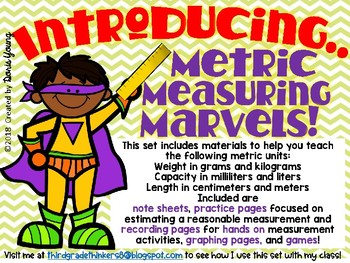Centimeters, liters, grams, milliliters, meters, kilograms....for most third graders these are unfamiliar, rather confusing math and science words. They get so jumbled in their little brains! Learning the metric units and understanding them to the point of applying them can be a struggle. If your students are anything like mine, they need plenty of exposure to the words and lots of hands on practice using them.
We are working on becoming "Metric Measurement Marvels"!
If we are to become one, then we must be sure we understand the units, can measure with them AND make reasonable estimations.

We will work through measurements of length, weight and capacity and record our learning along the way. Here are the pages that we fill out with all the important information that we have to learn.
Last year we folded our pages and stapled them to make a booklet.

We are keeping math notes in a marble composition book this year.
It comes in handy as we can go back to prior learning if we need to review a concept.

As I introduced units of length, we added them to our journals.
We learned benchmarks for each one....the centimeter is about the width of our fingernail and the meter is about the width of an arm span. Referring to these benchmarks helps when we need to make estimations of length.

Students get practice using the tools to measure items and then they record them on a chart and finally transfer the data to a bar graph. I'm always looking for ways to connect prior math learning and this allows students another opportunity to apply graphing skills.

The pages are set up for students to work through: "What I Know", "What I Can Do" and
"What I Can Create" using each type of metric measurement.

My students worked on their measurement skills at a math station during guided math time.
It was easier to gather the materials for six students at a station as opposed to the whole class trying to work on it at the same time. Really, since my students worked in partners, it was just three balance scales, three tubs of rice and three rulers.
Having to record their measurements in the booklet or math journal made them accountable for the work. Allowing for whole group math talk time afterwards helped to make sure students were understanding the concepts.

The other part of our standard involves students making reasonable estimations.
Students enjoyed playing these spinner games with a partner.
Working with a partner allowed students to share their thinking and their rationale.
Here is where I wanted to hear them using their "benchmarks" to help them.

Verbalizing their thinking is essential. When doing a paper task like the one below, I always have the class check papers right afterwards.
Immediate feedback on a skill like this one is so critical!

We still have more learning to do!
This is a skill that needs to be intentionally reinforced and will show up in more math stations as we go through the rest of the year.
I'll be posting how I reinforce measurement through my behavior system next.
Follow my blog or check back soon!
If you are interested in using these materials with your students you can check it out in my store.
Just click the link below:

Metric Measuring Marvels
How do you handle the challenge of teaching the metric units to your students?
Would LOVE to hear!
Let's help each other out....
Comment below or email at youngdor8@gmail.com!

The pages are set up for students to work through: "What I Know", "What I Can Do" and
"What I Can Create" using each type of metric measurement.

My students worked on their measurement skills at a math station during guided math time.
It was easier to gather the materials for six students at a station as opposed to the whole class trying to work on it at the same time. Really, since my students worked in partners, it was just three balance scales, three tubs of rice and three rulers.
Having to record their measurements in the booklet or math journal made them accountable for the work. Allowing for whole group math talk time afterwards helped to make sure students were understanding the concepts.

The other part of our standard involves students making reasonable estimations.
Students enjoyed playing these spinner games with a partner.
Working with a partner allowed students to share their thinking and their rationale.
Here is where I wanted to hear them using their "benchmarks" to help them.

Verbalizing their thinking is essential. When doing a paper task like the one below, I always have the class check papers right afterwards.
Immediate feedback on a skill like this one is so critical!

We still have more learning to do!
This is a skill that needs to be intentionally reinforced and will show up in more math stations as we go through the rest of the year.
I'll be posting how I reinforce measurement through my behavior system next.
Follow my blog or check back soon!
If you are interested in using these materials with your students you can check it out in my store.
Just click the link below:

Metric Measuring Marvels
How do you handle the challenge of teaching the metric units to your students?
Would LOVE to hear!
Let's help each other out....
Comment below or email at youngdor8@gmail.com!


 youngdor8@gmail.com
youngdor8@gmail.com




















0 comments:
Post a Comment